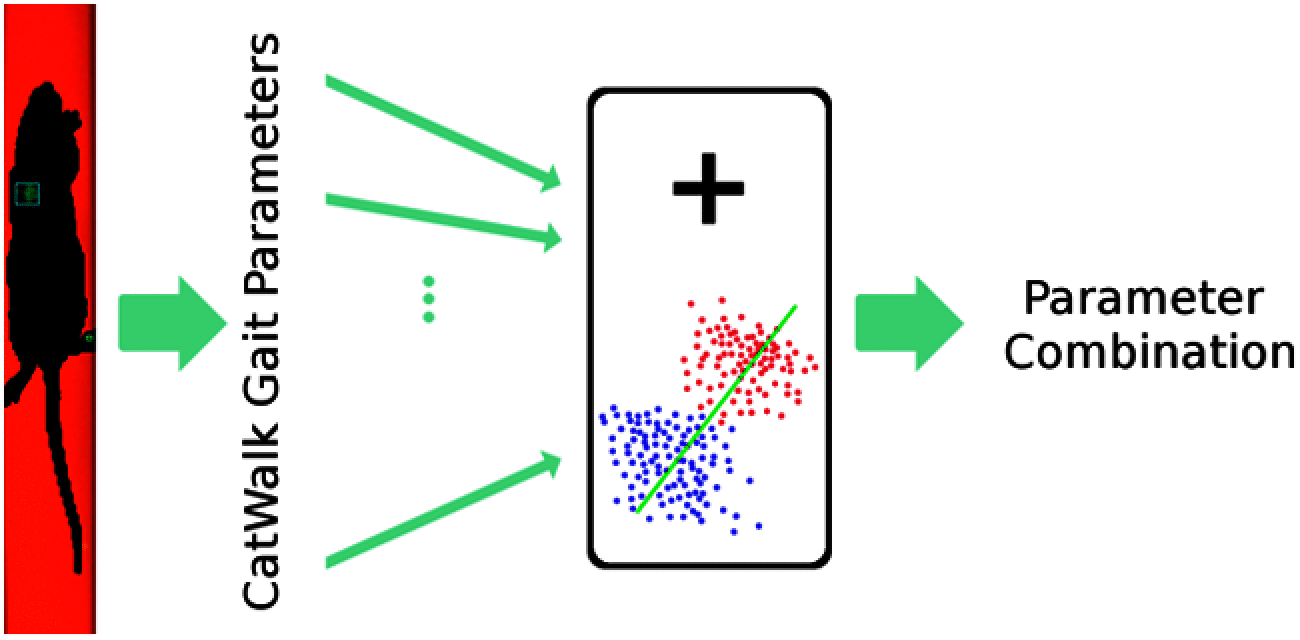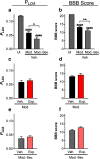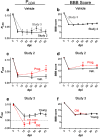Combination of Defined CatWalk Gait Parameters for Predictive Locomotion Recovery in Experimental Spinal Cord Injury Rat Models
- PMID: 33593735
- PMCID: PMC7986542
- DOI: 10.1523/ENEURO.0497-20.2021
Combination of Defined CatWalk Gait Parameters for Predictive Locomotion Recovery in Experimental Spinal Cord Injury Rat Models
Abstract
In many preclinical spinal cord injury (SCI) studies, assessment of locomotion recovery is key to understanding the effectiveness of the experimental intervention. In such rat SCI studies, the most basic locomotor recovery scoring system is a subjective observation of animals freely roaming in an open field, the Basso Beattie Bresnahan (BBB) score. In comparison, CatWalk is an automated gait analysis system, providing further parameter specifications. Although together the CatWalk parameters encompass gait, studies consistently report single parameters, which differ in significance from other behavioral assessments. Therefore, we believe no single parameter produced by the CatWalk can represent the fully-coordinated motion of gait. Typically, other locomotor assessments, such as the BBB score, combine several locomotor characteristics into a representative score. For this reason, we ranked the most distinctive CatWalk parameters between uninjured and SC injured rats. Subsequently, we combined nine of the topmost parameters into an SCI gait index score based on linear discriminant analysis (LDA). The resulting combination was applied to assess gait recovery in SCI experiments comprising of three thoracic contusions, a thoracic dorsal hemisection, and a cervical dorsal column lesion model. For thoracic lesions, our unbiased machine learning model revealed gait differences in lesion type and severity. In some instances, our LDA was found to be more sensitive in differentiating recovery than the BBB score alone. We believe the newly developed gait parameter combination presented here should be used in CatWalk gait recovery work with preclinical thoracic rat SCI models.
Keywords: CatWalk; gait parameter; linear discriminant analysis; locomotion recovery; preclinical development; spinal cord injury.
Copyright © 2021 Timotius et al.
Figures







Similar articles
-
Assessment of hindlimb motor recovery after severe thoracic spinal cord injury in rats: classification of CatWalk XT® gait analysis parameters.Neural Regen Res. 2023 May;18(5):1084-1089. doi: 10.4103/1673-5374.355763. Neural Regen Res. 2023. PMID: 36254997 Free PMC article.
-
Coordination function index: A novel indicator for assessing hindlimb locomotor recovery in spinal cord injury rats based on catwalk gait parameters.Behav Brain Res. 2024 Feb 29;459:114765. doi: 10.1016/j.bbr.2023.114765. Epub 2023 Nov 20. Behav Brain Res. 2024. PMID: 37992973
-
Effects of early surgical decompression on functional and histological outcomes after severe experimental thoracic spinal cord injury.J Neurosurg Spine. 2017 Jan;26(1):62-75. doi: 10.3171/2016.6.SPINE16343. Epub 2016 Sep 16. J Neurosurg Spine. 2017. PMID: 27636866
-
CatWalk-assisted gait analysis in the assessment of spinal cord injury.J Neurotrauma. 2006 Mar-Apr;23(3-4):537-48. doi: 10.1089/neu.2006.23.537. J Neurotrauma. 2006. PMID: 16629635 Review.
-
Kinematic and kinetic gait analysis to evaluate functional recovery in thoracic spinal cord injured rats.Neurosci Biobehav Rev. 2019 Mar;98:18-28. doi: 10.1016/j.neubiorev.2018.12.027. Epub 2019 Jan 3. Neurosci Biobehav Rev. 2019. PMID: 30611796 Review.
Cited by
-
Gait Analysis Using Animal Models of Peripheral Nerve and Spinal Cord Injuries.Biomedicines. 2021 Aug 19;9(8):1050. doi: 10.3390/biomedicines9081050. Biomedicines. 2021. PMID: 34440252 Free PMC article. Review.
-
Clicker Training Mice for Improved Compliance in the Catwalk Test.Animals (Basel). 2022 Dec 15;12(24):3545. doi: 10.3390/ani12243545. Animals (Basel). 2022. PMID: 36552465 Free PMC article.
-
[Effects of α1-antitrypsin on motor function in mice with immature brain white matter injury].Zhongguo Dang Dai Er Ke Za Zhi. 2024 Feb 15;26(2):181-187. doi: 10.7499/j.issn.1008-8830.2309003. Zhongguo Dang Dai Er Ke Za Zhi. 2024. PMID: 38436317 Free PMC article. Chinese.
-
Assessment of hindlimb motor recovery after severe thoracic spinal cord injury in rats: classification of CatWalk XT® gait analysis parameters.Neural Regen Res. 2023 May;18(5):1084-1089. doi: 10.4103/1673-5374.355763. Neural Regen Res. 2023. PMID: 36254997 Free PMC article.
-
Neuroprotective effect and possible mechanism of edaravone in rat models of spinal cord injury: a protocol for a systematic review and meta-analysis.Syst Rev. 2023 Sep 26;12(1):177. doi: 10.1186/s13643-023-02306-1. Syst Rev. 2023. PMID: 37752580 Free PMC article.
References
-
- Ahuja CS, Wilson JR, Nori S, Kotter MRN, Druschel C, Curt A, Fehlings MG (2017) Traumatic spinal cord injury. Nat Rev Dis Prim 3:17018. - PubMed
-
- Asboth L, Friedli L, Beauparlant J, Martinez-Gonzalez C, Anil S, Rey E, Baud L, Pidpruzhnykova G, Anderson MA, Shkorbatova P, Batti L, Pagès S, Kreider J, Schneider BL, Barraud Q, Courtine G (2018) Cortico-reticulo-spinal circuit reorganization enables functional recovery after severe spinal cord contusion. Nat Neurosci 21:576–588. 10.1038/s41593-018-0093-5 - DOI - PubMed
MeSH terms
LinkOut - more resources
Full Text Sources
Other Literature Sources
Medical
